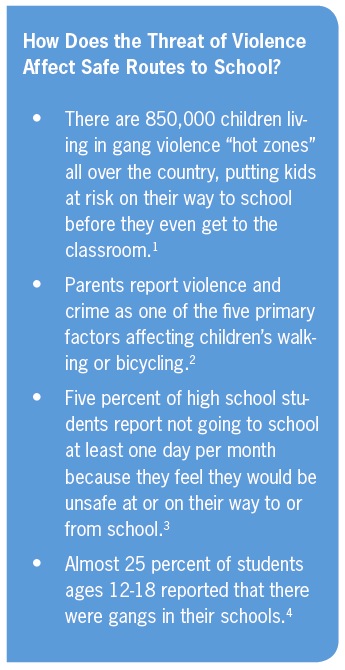SAFE ROUTES TO SCHOOL NATIONAL PARTNERSHIP
 In some communities, the danger of violence and crime discourages children from walking to school and keeps people off the street, limiting physical activity and restricting errands and trips. Violent crime and conflict can cause death, pain, and trauma, both for those directly affected and for those who witness or learn of events. Preventing violence goes hand in hand with community betterment, public engagement, street scale enhancements, physical activity and improved economic opportunities.
In some communities, the danger of violence and crime discourages children from walking to school and keeps people off the street, limiting physical activity and restricting errands and trips. Violent crime and conflict can cause death, pain, and trauma, both for those directly affected and for those who witness or learn of events. Preventing violence goes hand in hand with community betterment, public engagement, street scale enhancements, physical activity and improved economic opportunities.
In underserved communities, walking and bicycling are often major ways that people get around – a necessary part of getting to school, work, the grocery store, or to other key destinations. In addition, walking and bicycling may be a particularly affordable and accessible means to get physical activity.5 At the same time, there is often more danger from traffic and from violence on the street in underserved communities.6 Violence within a community inhibits business, job access, healthy nutritional choices, and physical activity. Addressing violence within underserved communities is critical to economic renewal and health.
Combatting Violence Through Safe Routes to School
Violence and crime affect children in communities across the country. In many communities, the actual risk of harm to children is very low, and Safe Routes to School programs can play a crucial role in helping parents feel comfortable with children’s active transportation to school. In other communities, however, children face very real dangers of robbery, harassment, gang intimidation and gang recruitment. Safe Routes to School programs can assist significantly in increasing the safety of children and teens in these communities.
How can Safe Routes to School programs help with these problems? A range of potential steps are provided below. Planning and community engagement can assist in determining which of the steps are most needed and appropriate for a given community.
Using a framework known as the “Six E’s,” we identify specific kinds of actions that can combat violence and support Safe Routes to School. Safe Routes to School programs often use this framework to describe the steps that ensure that children can walk and bicycle safely to school. The Six E’s are engineering, education, encouragement, enforcement, evaluation, and equity, which sets out the need for fair opportunities for health for all communities.
Engineering – Making operational and physical improvements to the built environment that discourage violence and increase street safety
- Increase the walkability and bikeability of underserved communities. Designing communities to be more walkable makes streets safer, slows car speeds, decreases crime and helps residents become more active.7 Be sure that designs for street scale improvements in underserved communities are carefully reviewed and don’t compromise safety.
- Build a coalition that can develop a Safe Routes to School plan that identifies potential safety problems and prioritizes needed improvements. For example, map locations of brownfields and abandoned areas, as they can be hubs for violence and fear, and identify methods of revitalizing these areas.
- Increase trees, landscaping and green space in communities.
- Use techniques of “crime prevention through environmental design” (CPTED) to reduce opportunities for crime that may be inherent in the design of the neighborhood, influencing the offender decisions that precede criminal acts. This includes steps such as ensuring that streets and buildings have abundant pedestrian scale lighting and eliminating locations where someone can lie in wait to rob or harm someone.
Download full version (PDF): Using Safe Routes to School to Combat the Threat of Violence
About the Safe Routes to School National Partnership
www.saferoutespartnership.org
“The Safe Routes to School National Partnership’s mission is to advance safe walking and bicycling to and from schools, and in daily life, to improve the health and well-being of America’s children and to foster the creation of livable, sustainable communities.”
Tags: Bicycling, Cycling, Pedestrian, Safe Routes to School National Partnership






 RSS Feed
RSS Feed